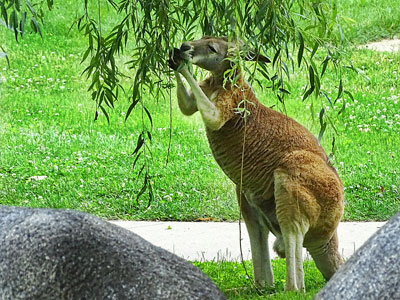Center for Zoo and Aquarium Animal Welfare

Visitor Effects on Kangaroos During and After a Covid Zoo Closure
Visitor effects are a popular area of welfare research in zoo settings. Previous research has demonstrated a lot of variability between species and individuals in how they respond to visitor density and behavior. Despite the prevalence of this research, there is little focus on walk-through habitats, which are popular in zoos because they allow guests closer proximity to wild animals and unique immersive opportunities. Kangaroos and wallabies are popular choices for these spaces and reside in an established walk-through habitat at the Detroit Zoo. As with many other public institutions, the Detroit Zoo temporarily closed to the public in 2020 due to the outbreak of the COVID-19 pandemic. This closure offered an unprecedented opportunity to compare the behavior and space use of 15 red kangaroos (Macropus rufus) between visitor density conditions. After the Zoo reopened to the public, we observed increases in social proximity and time spent inactive, as well as decreased space use. Some individuals displayed departures from the group-level trends, differences we attributed to individual life history, rearing and personality. These results highlight the importance both of considering visitor effects on animal welfare and evaluating animal welfare on an individual basis.
See All Other Projects
- 1.Behavioral and Physiological Development of Polar Bear Cubs
- 2.Behavioral Effects of Visitor Presence on Six Reptile Species
- 3.Effects of Cataract Surgery on Crested Penguins
- 4.Exploring and Mitigating Visitor Effects on Reptile Welfare
- 5.Impact of Behavioral Opportunities on Aardvark Welfare
- 6.Impacts of Installing New Habitat Structures on Mammal Welfare
- 7.Implications of Personality in Blanding’s Turtles
- 8.Increasing Space and Habitat Complexity for King Penguin Welfare
- 9.The Effects of Habitat Complexity on Snake Welfare
- 10.The Impact of Browse on the Welfare of Gorillas
- 11.Using Foraging Ecology to Understand Warthog Habitat Preferences
- 12.Using Infrared Thermography to Understand Gorilla Welfare
- 13.Validating a New Indicator of Welfare for Grizzly Bears
- 14.Validating and Applying a Qualitative Behavioral Assessment Tool Designed for Gorillas
- 15.Welfare Effects of Injuries Obtained in the Wild for Non-Releasable Sandhill Cranes